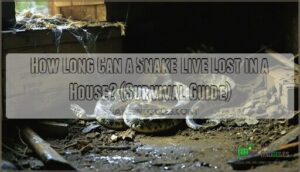This site is supported by our readers. We may earn a commission, at no cost to you, if you purchase through links.

They’re experts at hide and seek, slipping into warm, tight spaces and barely moving if it gets chilly. While your missing pet isn’t likely munching on snacks from the pantry, it doesn’t need frequent meals.
Give a careful look behind furniture and appliances, and don’t be surprised if it pops up just when you least expect it—there’s more to uncover next.
Table Of Contents
- Key Takeaways
- Searching for a Lost Snake in Your House
- Safety Measures During The Search
- Post-Discovery Snake Care
- Case Study: TIE Fighter’s Disappearance and Discovery
- Places You Can Find a Lost Snake in Your House
- Frequently Asked Questions (FAQs)
- How long can a snake live inside a house?
- How long can a snake live?
- How long can a snake survive without food or water?
- What to do if you find a snake in Your House?
- What happens if a snake escapes?
- Why do snakes need a warm house?
- What are some common signs that a snake may be hiding in your house?
- What steps should I take after discovering a lost snake in my house?
- How can I prevent my snake from escaping its tank again in the future?
- Can a lost snake find food in a house?
- Conclusion
Key Takeaways
- Your snake can survive for weeks or even months in your house, thanks to its low energy needs and knack for hiding in warm, tight spaces.
- Always search methodically through dark corners, behind furniture, and near heat sources—snakes pick spots where they feel safest.
- Secure your home by blocking escape routes, keeping pets away, and regularly checking potential hiding places until you find your snake.
- After finding your snake, check its health, upgrade tank security, and stick to a routine for prevention and peace of mind.
Searching for a Lost Snake in Your House
When you discover your snake is missing, start your search immediately in the room where you last saw it. Snakes prefer warm, hidden areas where they feel secure, so check dark spaces like under furniture, behind appliances, and in wall cracks.
Possible Hiding Spots
Your snake could be hiding anywhere in your house. Snakes seek dark corners, warm areas, and small spaces where they feel secure. They’re escape artists who can squeeze into unusual nooks and hidden crevices you mightn’t consider.
Common snake hiding places include:
- Under furniture – sofas, beds, dressers where it’s dark and quiet
- Near heat sources – water heaters, furnaces, kitchen appliances
- Wall gaps and cracks – baseboards, behind picture frames, outlet covers
- Storage areas – closets, basements, attics with boxes or clutter
Check potential hiding spots thoroughly. Snakes can fit through openings much smaller than their body width. During colder months, they might enter a state of reduced activity known as brumation.
Luring Methods
Once you’ve identified potential hiding spots, you’ll need effective luring methods to coax your lost snake into the open. These techniques work by appealing to your snake’s natural instincts and basic needs.
Start with scent trailing—your most powerful tool. Place live mice in ventilated containers near suspected hiding areas. The strong scent will travel through air vents and floor gaps, creating an irresistible trail. Move these containers between rooms every few hours to spread the attraction.
Try the flour technique for tracking movement. Sprinkle flour along walls and doorways to create visible paths showing where your snake travels at night. This method reveals activity patterns and narrows your search area.
Consider these proven luring methods:
- Warmth temptation – Place heating pads near suspected hiding spots
- Sound attraction – Stack dominoes or pennies that topple when disturbed
- Scent trails – Use familiar bedding or shed skin from the tank
- Food placement – Position thawed rodents in quiet, dark corners
- Domino effect – Create noise markers along likely travel routes
Most snakes emerge during evening hours when houses quiet down. Be patient and check your lures regularly. To improve your chances, remember to search adjacent rooms after thoroughly checking the initial area.
Actions During Search
During your search of your house, stay calm and move methodically through snake hiding spots. Secure pets in separate rooms to guarantee family safety while searching for a lost snake.
Wear gloves when checking potential snake hiding places under furniture and in dark corners. Check traps regularly and examine areas twice, as snakes are skilled at remaining motionless.
Document your search progress to avoid missing locations during this systematic process.
Safety Measures During The Search
When searching for your lost snake, you’ll need to protect yourself and your family from potential encounters with a stressed or defensive animal.
Secure other pets in separate rooms, wear protective gloves, and move slowly to avoid startling the snake during your search efforts.
Handling The Situation
Three essential steps will keep everyone safe when your snake is lost in your house. Stay calm to avoid startling the snake if encountered. Secure pets immediately—cats and dogs can harm or be harmed by a frightened snake. Notify neighbors with the snake’s photo, as temperature changes may drive it outdoors.
It’s also important to learn about snake safety precautions to minimize risks during encounters. Use strategic placement of warm spots and food availability to encourage the snake’s return to familiar areas.
Preventing Escape
While searching for your lost snake, preventing escape becomes your top priority. Close all doors immediately to contain the search area and eliminate potential escape routes. Secure windows tightly and inspect door frames for gaps. Understanding species behavior helps predict movement patterns – most snakes seek warm, dark spaces rather than open areas.
Focus on tank security by examining your original enclosure design for weaknesses. Seal wall cracks and floor gaps with tape or towels. Block ventilation systems with mesh screens. Remove clutter that creates hiding spots and complicates searches. You can also explore snake repellent options to deter snakes from entering your home.
Monitor entrances constantly during the search. One person should watch exits while others search. This prevents the snake from slipping past unnoticed. Regular verification of tank security after recovery prevents future incidents. Consider upgrading enclosure latches and adding secure handling protocols. Professional assistance ensures safe recapture without injury to you or your snake.
Ensuring Family Safety
Beyond preventing escape, your family’s well-being takes priority when a lost snake roams your home. Keep children away from Snake Hiding Places by establishing clear boundaries around search areas. Create a safe environment by securing pets in separate rooms – cats and dogs might corner or provoke the snake, leading to defensive strikes.
Develop an Emergency plan that includes bite prevention protocols and immediate medical contact information. Brief family members on Snake awareness basics: never attempt handling without protective gear. Pet Snake Safety extends to everyone under your roof.
Check traps regularly while maintaining distance, and designate snake-free zones where kids can move freely. Pet protection means keeping furry friends contained until recovery succeeds.
Post-Discovery Snake Care
Once you’ve found your escaped snake, you’ll need to check its health and secure its habitat to prevent future escapes.
Your snake may be dehydrated or stressed after its house adventure, so proper care and tank improvements are essential for its recovery.
Tank Management
Once you’ve safely retrieved your snake, proper tank management becomes your top priority. Your enclosure needs immediate attention to prevent another vanishing act. Start with these three steps:
- Escape-Proofing: Inspect every inch of your tank for gaps, loose lids, or weak spots where your snake squeezed through
- Security Verification: Test all latches, clips, and locks to confirm they’re working properly and can’t be pushed open
- Temperature Regulation: Check your heating elements and thermostats to maintain proper temperatures throughout the enclosure
Tank security isn’t just about keeping your snake inside. It’s about creating a safe space where they won’t feel the need to wander. Consider upgrading to specialized snake enclosure hardware for enhanced security. Replace any damaged screens or worn seals immediately.
Providing Optimal Living Conditions
After securing your pet snake’s tank management, focus on providing suitable living conditions that meet their species needs.
Create a warm environment with proper heat sources and temperature regulation—maintain 75-80°F on cool sides and 85-90°F on warm sides. Add tank enrichment like hiding spots, climbing structures, and varied substrates. Guarantee habitat security with appropriate humidity levels.
Offer diet variety through species-appropriate prey items fed every 7-14 days to support your snake’s health and natural behaviors.
Regular Verification of Tank Security
Check up on your pet snake’s tank security regularly to prevent future escape incidents. Regular verification of tank security involves systematic preventative maintenance and enclosure integrity assessments. Create a security checklist covering these essential escape-proofing methods:
- Lock mechanisms and latching systems
- Ventilation screens and mesh integrity
- Tank seams and structural weak points
Inspect your tank management setup weekly, examining hinges, clips, and any potential breach points. To prevent escapes, consider using wire locks for doors. This routine prevents your snake from becoming a house guest again. Proper tank security protects both your pet and household members from unexpected encounters.
Case Study: TIE Fighter’s Disappearance and Discovery
You’ll examine a real case where a ball python named TIE Fighter vanished for three months in a family home. This example shows how snakes can survive extended periods without food and demonstrates the search methods that finally led to successful recovery.
Missing for Three Months
Once your tank is secure, real stories show what snakes endure during extended disappearances. A lost snake can demonstrate impressive long-term survival abilities when missing for three months. Extended starvation becomes manageable as snakes reduce their metabolism by up to seventy percent. However, hydration concerns pose the greatest threat, with most species facing dehydration risks after two weeks. Behavioral changes include increased hiding and reduced movement to conserve energy. Environmental impact varies based on house temperature and available water sources.
Consider this survival timeline:
- Months 1-2: Snake relies on stored fat reserves while seeking food sources and water in snake hiding spots throughout the house.
Rescue Efforts and Contributors
During TIE Fighter’s extended absence, volunteer networks mobilized across multiple districts to coordinate rescue efforts. Amanda Sprouse led the search alongside her son Kingston, while Eileen Conway provided expert involvement through specialized techniques.
These rescue coordination efforts demonstrated how community support transforms a lost snake situation from hopeless to manageable. Search challenges included accessing tight spaces where the snake might hide.
The team used endoscopic equipment for finding lost snake in wall cavities and implemented various methods for luring out snake from hidden locations. This collaborative approach shows how organized volunteer networks can successfully locate even the most elusive lost snake through persistent community support.
Rescue Process and Challenges Faced
Successfully searching for a lost snake presents unique challenges that test even experienced rescuers. Snake survival in a house creates complex rescue scenarios where escape prevention becomes critical.
Common rescue process and challenges include:
- Search difficulties in tight spaces like insulation or wall cavities
- Species identification problems affecting handling approaches
- Resource limitations restricting access to specialized equipment
- Emotional impact on families during extended searches
- Physical barriers preventing safe extraction attempts
Professional rescue efforts often require modified techniques when snakes evade standard detection tools like endoscopes or thermal cameras.
Community Support and Reactions
Beyond the rescue process and challenges faced, community support became the backbone of TIE Fighter’s recovery. Volunteer networks mobilized through social media platforms, spreading public awareness about searching for a lost snake.
The emotional impact on neighbors was profound as they joined rescue efforts. Families learned that they should support snake bodies fully during handling to prevent stress. Expert consultations guided families, ensuring family safety while maintaining hope.
This community support demonstrated how collective action transforms individual struggles into shared victories.
Future Initiatives and Continued Support
Community education stands as the foundation for preventing future snake losses. You can help build volunteer networks that respond quickly to snake emergencies. These initiatives focus on reptile education for snake owners and technological integration like tracking devices.
- Preventative Measures: Teaching proper tank security and habitat enrichment techniques
- Community Support: Establishing rapid response teams for lost reptile cases
- Conservation Efforts: Promoting responsible snake ownership through educational programs
- Technological Integration: Implementing GPS tracking and monitoring systems for pet snakes
Places You Can Find a Lost Snake in Your House
Snake-detection efforts require methodical searches through furniture hiding spots where your escaped reptile likely seeks shelter. Check under couches, beds, and dressers first since snakes prefer dark places that offer security.
Wall crack havens provide perfect squeeze-through opportunities, so examine baseboards and gaps behind picture frames carefully. Don’t skip ceiling search areas, including attics and light fixtures, where snakes can climb surprisingly high.
Heat source vicinity areas like near water heaters, ovens, and heating vents attract cold-blooded creatures seeking warmth. Basement hiding places offer cool retreats, especially around stored boxes and old furniture.
Look inside appliances with small openings, unused camping gear, and behind electronic devices with vents. Indoor plants create natural hiding spots with their dense foliage and warm sunlight exposure.
Remember, snakes are master escape artists who can fit through openings smaller than their body diameter, making thorough searches essential for recovering your snake in your house safely.
Frequently Asked Questions (FAQs)
How long can a snake live inside a house?
Hide, slither, and wait—your missing reptile can survive in a house for four to five weeks, sometimes even two months. With a knack for finding cozy spots, it’ll hang on without food surprisingly long.
How long can a snake live?
You’d be surprised—most pet snakes can live up to 15 or 20 years if you take care of them right.
Just like us, they need regular meals, warmth, and a safe place to relax.
How long can a snake survive without food or water?
You’re looking at about four to five weeks without food for most snakes, though water’s a different story—dehydration sets in fast.
Give yours a water dish. Even snakes need to wet their whistle sometimes.
What to do if you find a snake in Your House?
If you spot one slithering indoors, stay calm and give it space. **Close the room’s doors, keep pets away, and call animal control.
**
Don’t try wrangling it yourself—safety comes first, not heroics.
What happens if a snake escapes?
Don’t panic if your snake gets loose! It’ll usually hide somewhere warm and quiet, squeezing into tight spaces.
Check behind furniture, near heaters, and under appliances. Keep other pets away, and watch for unusual movement or sounds.
Why do snakes need a warm house?
Snakes need a warm house because they rely on outside heat to stay active and healthy. If it gets too cold, their bodies slow down, making them sluggish.
Keep things cozy, your snake will thank you!
What are some common signs that a snake may be hiding in your house?
Ever notice odd rustling behind the couch, a missing pet, or tiny shed skin in a dusty corner?
If your shoes suddenly rustle, or droppings appear where they shouldn’t, you might’ve an elusive houseguest nearby.
What steps should I take after discovering a lost snake in my house?
Carefully guide the snake into a safe container, checking it for injuries. Wash your hands afterward, secure its tank, and double-check all escapes.
Give fresh water, warmth, and let it settle—no heroics needed.
How can I prevent my snake from escaping its tank again in the future?
Think of a snake as a tiny Houdini; they’ll wriggle through any gap left unchecked. Always lock the tank lid, secure vents, and fill cracks.
Regularly inspect enclosures and teach everyone at home safe snake-handling basics.
Can a lost snake find food in a house?
You won’t see your pet hunting snacks in the kitchen—household food isn’t on its menu.
Lost snakes can’t find their usual prey indoors, so they mostly go hungry and stick close to hidden, dark corners.
Conclusion
Just as shadows stretch and shrink, so does the time a snake can live lost in a house—weeks, or even months, are possible. If you’re patient and methodical, you’ll likely find your missing friend hiding close by.
Stick to regular checks and safety steps, and remember—**how long can a snake live lost in a house oh my?
Quite a while**, but your calm, informed actions help guarantee a safe reunion for everyone involved.
- https://community.morphmarket.com/t/confession-escaped-corn-snake-feeling-guilty/40337?page=2
- https://www.bbc.com/news/articles/cn7622m65g2o
- https://www.reddit.com/r/ballpython/comments/1jow5fg/new_snake_daddy_3_weeks_in_and_shes_lost_in_the/
- https://www.victorpest.com/articles/will-snakes-come-indoors
- https://gohikevirginia.com/where-do-snakes-go-in-the-winter/











